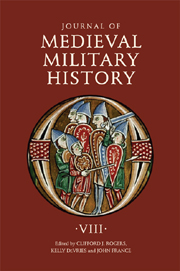Book contents
- Frontmatter
- Contents
- 1 People against Mercenaries: The Capuchins in Southern Gaul
- 2 The Last Italian Expedition of Henry IV: Re-reading the Vita Mathildis of Donizone of Canossa
- 3 Jaime I of Aragon: Child and Master of the Spanish Reconquest
- 4 Numbers in Mongol Warfare
- 5 Battlefield Medicine in Wolfram's Parzival
- 6 Battle-Seeking, Battle-Avoiding or perhaps just Battle-Willing? Applying the Gillingham Paradigm to Enrique II of Castile
- 7 Outrance and Plaisance
- 8 Guns and Goddams: Was there a Military Revolution in Lancastrian Normandy 1415–50?
- The Name of the Siege Engine trebuchet: Etymology and History in Medieval France and Britain
- Journal of Medieval Military History 1477–545
3 - Jaime I of Aragon: Child and Master of the Spanish Reconquest
Published online by Cambridge University Press: 12 September 2012
- Frontmatter
- Contents
- 1 People against Mercenaries: The Capuchins in Southern Gaul
- 2 The Last Italian Expedition of Henry IV: Re-reading the Vita Mathildis of Donizone of Canossa
- 3 Jaime I of Aragon: Child and Master of the Spanish Reconquest
- 4 Numbers in Mongol Warfare
- 5 Battlefield Medicine in Wolfram's Parzival
- 6 Battle-Seeking, Battle-Avoiding or perhaps just Battle-Willing? Applying the Gillingham Paradigm to Enrique II of Castile
- 7 Outrance and Plaisance
- 8 Guns and Goddams: Was there a Military Revolution in Lancastrian Normandy 1415–50?
- The Name of the Siege Engine trebuchet: Etymology and History in Medieval France and Britain
- Journal of Medieval Military History 1477–545
Summary
If “Africa begins at the Pyrenees” (a shaky truism that far too many medi-evalists still adhere to), the discussion of a Spanish ruler's reconquest career as a prime example of military leadership during the European Middle Ages may seem at worst pointless and at best ill-conceived. Since such geo-cultural divisions themselves would surely have seemed beyond the pale in the thirteenth century, however, this paper will proceed to assess the accomplishments of one of southern Europe's greatest generals of the high Middle Ages, Jaime (Jaume) I “the Conqueror” (r.1214–76).
Early Life
The stellar military record of this long-lived Aragonese sovereign was clearly the result of a fiery determination that transcended and redefined both royal and martial traditions of the day. Coming to the thrones of upland Aragon and maritime Catalonia as a six-year-old orphan who had lost his father, Pedro II (r.1196–1213), at the battle of Muret (12 September 1213), he quickly understood and took as his own the prevalent royal cant that made the ruler in eastern Spain into the principal protector of the “homeland’ (patria) and its “commonwealth” (cosa publica). Despite the possibilities inherent in the royal office, the young king, surrounded by over-mighty relatives who hoped to claim the Aragonese throne for themselves, spent the next decade in defending his royal rights while attempting to direct the energies of his querulous barons toward more profitable activities that he could control.
- Type
- Chapter
- Information
- Journal of Medieval Military History , pp. 69 - 108Publisher: Boydell & BrewerPrint publication year: 2010



